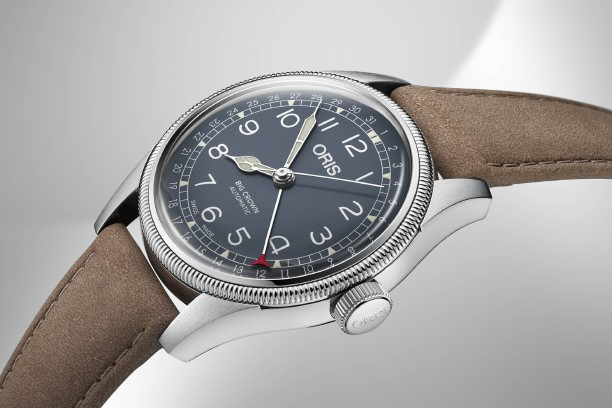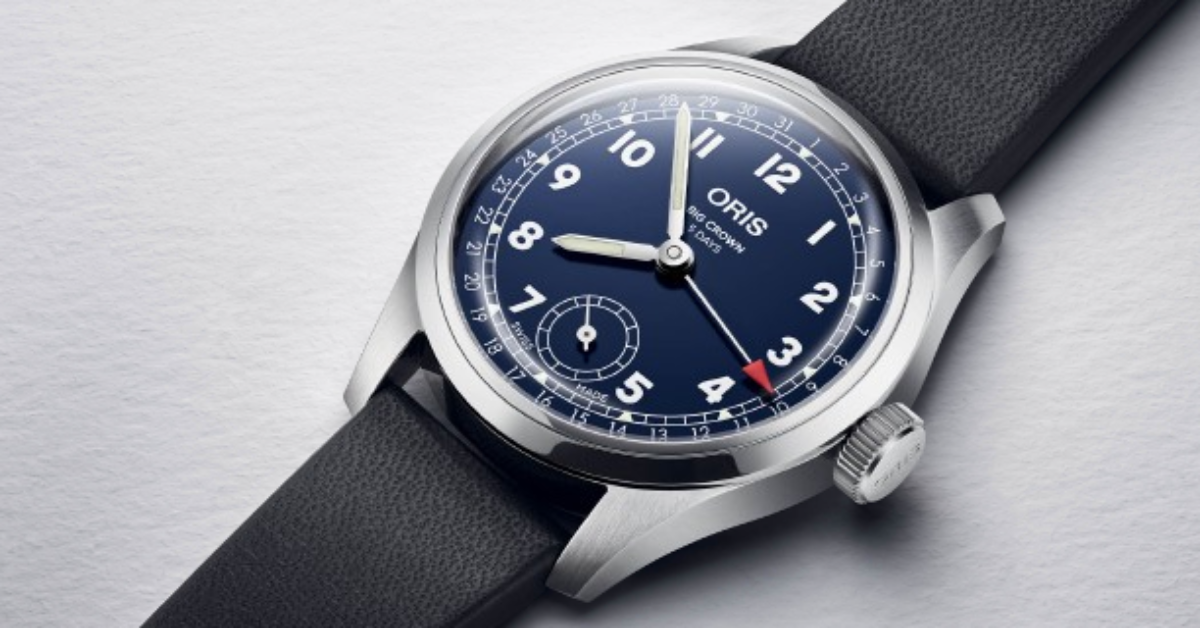A Timeless Elegance: Oris Big Crown Pointer Date Review
Genesis and early growth
Paul Cattin and Georges Christian founded Oris in the Swiss village of Hölstein. They purchased the recently shuttered Lohner & Co. watch manufacturing company and signed a deal with the local mayor on June 1, 1904. They named their new watch company Oris after a nearby brook, and they began manufacturing pocket watches on a large scale. Oris employed 67 workers in its first year.
In 1906, the company established an assembly facility and a second factory in Holderbank, a nearby town. In 1908, another manufacturing plant opened in Como. With almost 300 employees by 1911, Oris had become the major employer in Hölstein. Oris had produced nearly a million watches by 1914. It erected housing and apartments for its employees to tempt more watchmakers, and it expanded so that by 1929, it had other plants in Courgenay (1916), Herbetswil (1925), and Ziefen (1925). When all plants were fully operational, Oris promised that it could produce “one watch every three seconds.”
The first Oris wristwatches
Oris increased its product line with the establishment of the Ziefen factory and the Herbetswil electroplating plant. The business began to add bracelet buckles to its pocket watches, converting them into full-fledged wristwatches. Oris began by concentrating on the fledgling aircraft industry. By 1911, a pocket watch for pilots had been produced, and in 1917, Oris introduced its first wrist-worn pilot’s watch.
When firm co-founder Georges Christian died in 1927, Jacques-David LeCoultre took over as President of the Board of Directors. Jacques-David LeCoultre was Antoine LeCoultre’s grandson and the one who formed Jaeger-LeCoultre with Edmond Jaeger in 1937. Oscar Herzog, Christian’s brother-in-law, took over as general manager in 1928 after Georges Christian died a year earlier, a position he held for 43 years.
The Swiss Watch Statute
On March 12, 1934, the Swiss government passed the Watch Statute, which was meant to safeguard and regulate the Swiss watch industry. The regulation established a “cartel” of 2,241 designated member enterprises, 79% of which could employ no more than 20 people. Oris employed hundreds of people at the time, making it too huge to join the formal cartel of Swiss manufacturers. The rule made it illegal for large-scale watch companies to introduce new technologies without permission.

Oris ProDiver Chronograph
Despite continued commercial success with pin-lever escapements, Oris filed a lawsuit against the Watch Statute in order to adopt the more precise and durable lever escapement. Oscar Herzog, the company’s general manager, hired a young lawyer named Dr. Rolf Portmann in 1956, and he spent his first ten years at the company lobbying to repeal the Watch Statute. Following that, the Watch Statute was gradually liberalized until it was repealed in 1971.
Oris established its own dial manufacturing plant in Biel/Bienne in 1936. By that point, the business had manufactured practically every component of its watch and clock products in-house. The Big Crown, Oris’ hallmark pilot’s watch, was released in 1938. The line is named after the watch’s enormous crown, which was designed to help pilots adjust their watches while wearing leather gloves. This watch and its variants are still manufactured today.
Vintage Oris watches with pointer date complications
During WWII, Oris’s distribution network outside of Switzerland was drastically limited due to decreased consumer demand as well as government-imposed export and production restrictions. To stay in business, the company began producing alarm clocks. Throughout the war, alarm clock production outpaced wristwatch production.
Rolex’s patent on the central-rotor automatic movement expired in 1948, allowing Oris to debut their own automatic movement, complete with a power reserve indication, which was quite rare at the time (1952). In 1956, the business used its clock expertise to introduce an alarm function on its Calibre 601 timepiece. The first Oris Diver was produced in 1965, and it featured huge cardinal numerals highlighted by inverted lume wedges and Oris’ in-house movements in caliber 654 and calibre 484. The original diver was recreated in 2015 with the Divers Sixty-Five range of vintage-inspired dive watches.
The Quartz Crisis
By the end of the 1960s, Switzerland had produced 44% of all watches sold globally. Oris employed 800 people throughout a network of factories in Hölstein and elsewhere, producing 1.2 million watches and clocks every year, making it one of the world’s ten largest watch makers. Every year, the company trains 40 engineers and watchmakers using its own equipment and technology, and it even runs an apprenticeship program.
On December 25, 1969, Seiko launched the Astron, the world’s first quartz watch, ushering in the quartz revolution. At the 1970 Basel Fair, the Ebauches SA Beta 21 was the first Swiss quartz analog watch. Numerous manufacturers, including Omega Electroquartz, released Beta 21. Hamilton debuted the Pulsar, the world’s first electronic digital watch, on May 6, 1970. Quartz timepieces from Asia dominated the market in the 1970s and early 1980s. The so-called ‘Quartz Crisis’ resulted in the closure of around 900 Swiss watch firms and the layoff of two-thirds of the watch industry’s workforce. The global market share of Swiss manufacturers has fallen to 13%.
Oris lost its independence in 1970 and became a subsidiary of Allgemeine Schweizer Uhrenindustrie AG (ASUAG), the precursor of the Swatch Group. To compete with the Japanese, the parent company’s management forced Oris to make quartz watches. This, however, did not restore success. Oris employed only a few dozen individuals in the early 1980s. The fabrication of its own movements was discontinued in 1981.
Independence

Oris, like many other Swiss watchmakers in the early 1980s, was on the verge of bankruptcy. Dr. Rolf Portmann, who was crucial in changing the Watch Statute, and Head of Marketing Ulrich W. Herzog took over the rest of the company in 1982 as part of a management buyout. Oris became an independent firm as a result of this. Soon after, Oris SA, a newly created and independent company, decided to forego quartz in favor of producing mechanical clocks in the mid-price range. Oris debuted the Caliber 418 alarm wristwatch in 1988, which included its own alarm module that used a genuine gong. By 1992, the firm was only producing mechanical watches.
It also produces a very small series of luxury promotional watches under the ‘Saros’ brand at the request of large companies for very special occasions. These watches made in Hölstein are only recognizable by the inscriptions on the back, the frame being fully dedicated to the subject of the promotion. The movements of these bespoke watches are mainly quartz, made in Switzerland.
The brand remains one of the very few Swiss watch manufacturers independent from large groups such as Swatch, Richemont, or LVMH.
21st Century
Since the millennium’s turn, the corporation has focused on the watch market sectors of diving, culture, aviation, and motor sports.
Oris Aquis Depth Gauge
Diving: In 2004, the Quick Lock Crown system was invented, which takes only a single 120-degree clockwise spin to hold the crown in place. Oris created the Rotation Safety System in 2009, a system that locks a diving watch’s unidirectional rotating bezel into place, preventing inadvertent adjustment underwater. In 2013, Oris patented their first mechanical depth gauge, the Oris Aquis Depth Gauge. Water enters the channel through a small hole at 12 o’clock. Under pressure, water enters the hole, leaving a watermark that corresponds to a depth gauge. The Aquis diver watch series, which features the in-house Calibre 400 and the Quick Strap Change System, remains the brand’s flagship product as of the early 2020s.
The Artelier Worldtimer (2004) was released as part of the brand’s “Oris Centennial Set” to commemorate its 100th anniversary. A global timer displays time in all 24 major time zones, typically via a ring with the names of cities representative of each zone. The Artelier Worldtimier, on the other hand, has a pivoting 2-way bezel that allows the wearer to advance or reverse the local hour hand in single-hour increments while also driving the date.
Although the “Motor Sport Collection” was launched in 1970 with the Chronoris model, the focus was sharpened in 2003 with a partnership with Formula One team Williams Racing, resulting in the 2015 release of the “Williams” with stainless steel or black carbon fiber and titanium cases, a sporty, black rubber band, a dark face, and blue team-colored accents. Oris ended its F1 sponsorship in 2018 because the watchmaker’s focus switched to environmental conservation.
Oris Calibre 110 02
Since 2002, the Red Rotor has been Oris’ registered trademark and distinguishing characteristic, and it can be seen via transparent casebacks on many Oris watches.
Oris sponsored a municipal event in Hölstein in 2005 that featured a happy bear. This “Oris Bear” went on to become the company’s mascot.
Oris commemorated 110 years of watchmaking in 2014 with its first in-house caliber in 35 years. Calibre 110 was a hand-wound movement with a patented non-linear power reserve indicator and a 10-day power reserve. It had a 6-foot (1.8-meter) spring and an unusually large barrel spring. It was the outcome of a ten-year partnership between Oris and L’École Téchnique Le Locle. Oris released the Calibre 400 in 2020, an in-house movement that is anti-magnetic up to 2250 gauss, with a 5-day power reserve (120 hours), a 10-year service interval, and a 10-year warranty. Since 2014, Oris has been developing its in-house Movement Creation Program, which has resulted in the release of 10 new mechanical calibers over the last decade, the most recent of which was introduced in 2017.
Oris was selected as the official timekeeper at Lord’s Cricket Ground in 2022, the first time in the club’s 230-year history.
Notable models

Oris Pointer Date: 1938
The Big Crown Pointer Date (1938) included an oversized crown that could be readily manipulated by a pilot wearing gloves, as well as big Arabic numerals for quick time reading in the cockpit. It had a fluted bezel and a date hand in the center with a pointer tip. In 2022, a new variant was released with a bronze 40mm case and Oris’s Calibre 754 automatic movement.
8-Day-Clock (1949)
Chronoris (1970): A 60-second timer with an internal bezel set by the crown at 3, and a winding and time-setting crown at 4. The timer is started, stopped, and reset by the pusher at 2. The model was relaunched in 2005 as the Chronoris Date, using the Oris automatic caliber 733, based on the Sellita SW 200-1, and again in 2017.
Oris Worldtimer (1997) contained a time zone complication, with pushers at 4 and 8:00 advancing or decreasing the main hour hand (local time) by one hour with each click. In 2017, a new model was produced that allowed the hour hand to be altered by spinning the bezel rather than using the previous model’s two-pusher method.
Aquis (2011) had a 300-meter water-resistant case with a screw-down crown; a ratcheting unidirectional dive-scale bezel; a domed sapphire crystal over the dial; a set of distinctive lugs that screw securely into the strap or bracelet; a date window at 6 o’clock; and was powered by the Oris Caliber 733. Oris began updating the Aquis line in 2017, and by 2023, there were 42 possible combinations in 39.mm, 41.5mm, and 43.5mm sizes.
Rectangular (2021): Oris’ first rectangular-shaped watch debuted in 1996 as a tribute to Miles Davis, and in 2008, a limited edition model was created in his honor. Neither had a lot of commercial appeal. Oris reintroduced the series in 2021, with four-sided stainless steel cases measuring 25.5mm in diameter and 30mm in length, making them smaller than prior rectangular Oris watches.
Coulson Limited Edition (2022): Inspired by Coulson Aviation’s efforts to combat wildfires and developed in collaboration with the Swiss Federal Institute of Technology, Oris employs a unique 3D printing process that prints both carbon fiber and PEKK aerospace-derived polymer at the same time to create an extremely light and rigid carbon fiber composite case.
ProPilot Altimeter (2023): the first wristwatch with an integrated mechanical altimeter, in which unscrewing the crown allows air to enter the case, allowing the watch to precisely display the wearer’s current altitude once the internal scale is calibrated to a referenced air pressure.
Related Article:
Navigating the Data Link Layer: Unraveling the Design Puzzle



